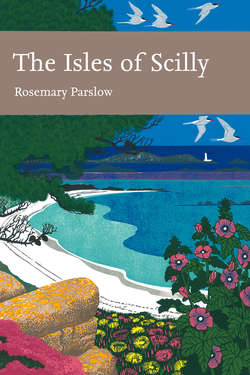Читать книгу The Isles of Scilly - Rosemary Parslow - Страница 28
THE EARLY HABITATS
ОглавлениеOf particular interest is Thomas’s (1985) description of the reconstructed palaeoenvironment of the early Scillonian landscape and the mapping of four main types of habitat. Some of the evidence for this he based on the pollen records, which unfortunately were limited to the few peat deposits and archaeological digs, and also on the distribution of some significant plants in Lousley’s Flora (1971). The four habitat types he described were stream-drained marsh, woodland, sand dune and open ground (including heath).
There are still marshlands in Scilly today, although they are nowhere near their former extent. Some of the land now under the sand flats between the islands could have been low-lying and boggy, but all that remains now are small wetlands at Higher Moors, Holy Vale and Lower Moors on St Mary’s, now much contracted in area. Even as recently as the 1960s there were wet fields from near Porthloo Pool and Rose Hill through to Lower Moors with yellow iris Iris pseudacorus, lesser water plantain Baldellia ranunculoides and hemlock water-dropwort Oenanthe crocata. Although these areas are still there they are now much drier and less species-rich. Another similar wetland area is now flooded and forms the Great Pool on Tresco. All the other streams and marshy areas are now lost under the sea, but some can still be traced from the geological record. Between Teän and St Martin’s is the deep channel of Teän Sound, which probably marks the route of a prehistoric stream.
One of the most interesting theories propounded by Thomas is his mapping of the ancient woodland cover on the islands by looking at the distribution of woodland species in Lousley’s Flora. From the pollen samples analysed by Dimbleby (1977) from Innisidgen and by Scaife (1984) from Higher and Lower Moors it would seem that Scilly was once covered in woodland. This woodland consisted of oak Quercus robur and birch Betula spp. with an understorey of hazel Corylus avellana and alder Alnus glutinosa (probably where there were wetter areas). Pollen evidence also included some ash Fraxinus excelsior and traces of yew Taxus baccata, and later hornbeam Carpinus betulus and elm Ulmus sp. Virtually nothing of this woodland is evident today, but support for the pollen evidence and what it tells us about former woodland distribution can be extrapolated from the present-day distribution of plants (known as ancient woodland indicators) that have strong ancient woodland associations, for example wood spurge Euphorbia amygdaloides and wood dock Rumex sanguineus (Kirby, 2004). In his Flora of the Isles of Scilly Lousley (1971) comments on a number of these woodland plants that were growing in non-woodland habitats. These fall in very neatly with the pattern of woodland 2000 years ago, as demonstrated by Thomas (Fig. 12).
Since 1971 additional plant records have reinforced the pattern. So it is possible to visualise the kind of woodland that may have grown on the islands at the time, possibly similar to the present-day Wistman’s Wood on Dartmoor, with stunted, twisted trees, wind-pruned into shape and only able to reach any reasonable height where they are sheltered in the hollows between the hills – as happens with the elms in Holy Vale today. The ground cover may have been open, with many of the species that still exist in Scilly. The trees and exposed rocks would also have supported luxuriant ferns and bryophytes. Other evidence of the ancient woodlands that existed on Scilly are the numbers of buried tree trunks that have been found on Tresco in the past, and the few oak Quercus sp. trees and woodland plants in the area still known as Tresco Wood. There are also records of submerged tree trunks on St Mary’s and, more reliably, St Martin’s.
FIG 12. The present distribution of AWI (ancient woodland indicator) plants may indicate where woodland existed before the submergence. (Updated since Thomas, 1985)
The work carried out between 1989 and 1993 by the Cornwall Archaeological Unit (Ratcliffe & Straker, 1996) on a number of cliff-face and intertidal deposits also provided exciting additional evidence for the deciduous Mesolithic/Neolithic forests. In addition, the CAU found further evidence that these forests were being replaced by heathland, grassland and cultivated plants by the Late Iron Age, as people began to have an impact on the land.
The other main habitats, sand dunes and heathlands, are still present. Many of the dunes have been flattened and have become vegetated with grassland and scrub, or are now cultivated fields. Heathlands and grasslands have resulted from the management of the open habitats over centuries. The land would have been utilised in many ways, from grazing for animals to the stripping of turf from the heath to use as fuel – once the inhabitants had cleared most of the woodland.
